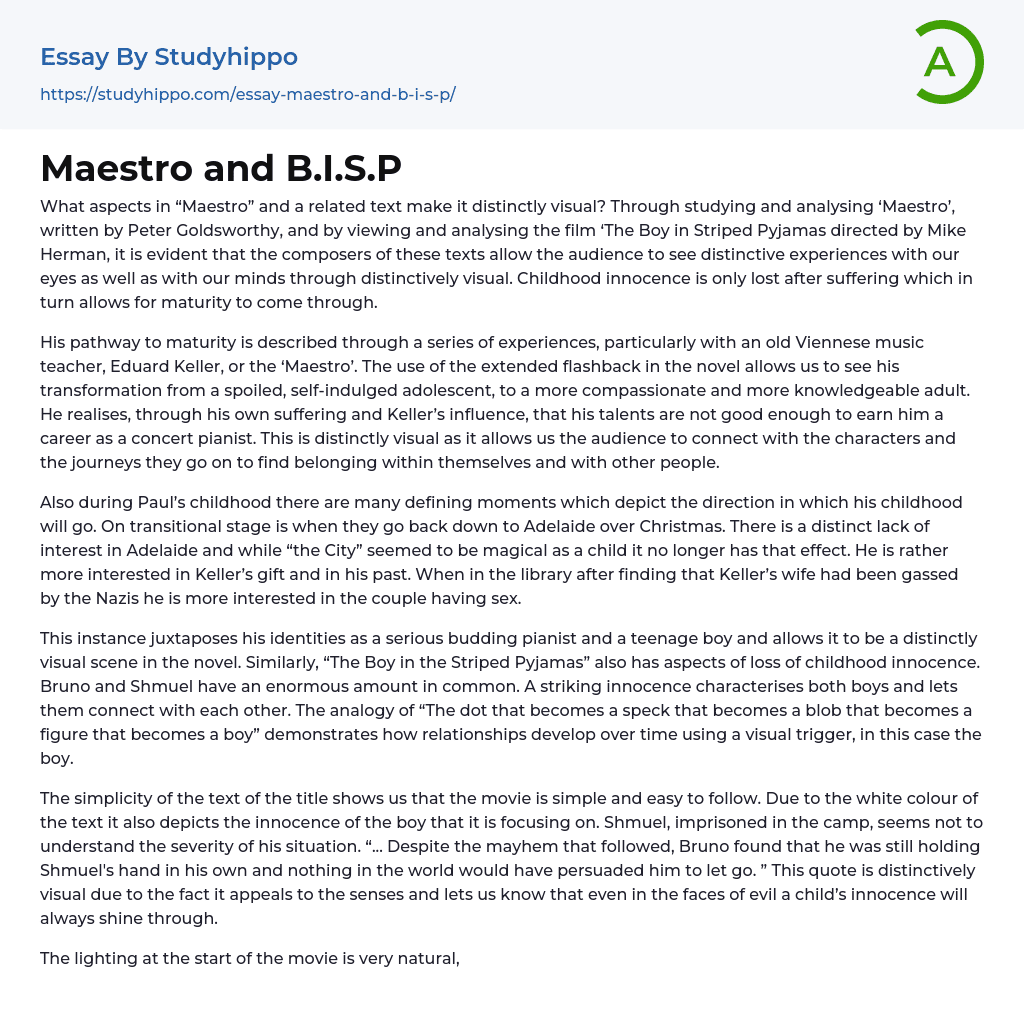Both Peter Goldsworthy's "Maestro" and Mike Herman's film, "The Boy in Striped Pyjamas," provide distinctive visual encounters. These works enable the audience to comprehend and perceive both mentally and visually. The journey from suffering to maturity leads to the loss of childhood innocence.
The theme of the novel revolves around the main character's journey towards maturity, which is depicted through various experiences. A significant part of this growth involves his interactions with Eduard Keller, a Viennese music teacher known as the 'Maestro.' The narrative employs extended flashbacks to illustrate how he transitions from a spoiled and self-indulgent teenager to a more compassionate and knowledgeable adult. Both his own suffering and Keller's guidance contribute to him realizing that his musical talents are inadequate for a career as a concert pia
...nist. This visual element allows the audience to empathize with the characters' quests for self-discovery and a sense of belonging.
During Paul’s childhood, there are several defining moments that indicate the path his childhood will take. One pivotal stage occurs when they return to Adelaide during Christmas. Paul shows little interest in Adelaide and no longer finds it as magical as he did when he was younger. Instead, he becomes more intrigued by Keller’s gift and his past. While in the library, Paul discovers that Keller’s wife was killed by the Nazis with gas, and yet his focus shifts to the couple engaged in sexual activity.
The passage discusses the portrayal of the main character in the novel as both a talented pianist and a teenage boy, emphasizing his dual identities. Additionally, "The Boy in the Striped Pyjamas" explores the loss of
childhood innocence as a theme. Bruno and Shmuel share several similarities, including their evident innocence, which creates a bond between them. The author uses an analogy of visual progress – starting from a dot and progressing to a speck, then a blob, and finally a figure – to represent the development of their relationship over time. This visual representation signifies the significance of the boy in their connection.
The title of the movie conveys its simplicity and ease of understanding. The white color of the text symbolizes the innocence of the boy it focuses on. Despite being imprisoned in a camp, Shmuel does not fully comprehend the seriousness of his situation. The quote, "Despite the mayhem that followed, Bruno found that he was still holding Shmuel's hand in his own and nothing in the world would have persuaded him to let go," emphasizes the visual aspect by appealing to the senses and illustrating that a child's innocence can prevail even in the face of evil.
The lighting at the beginning of the film creates a natural and cozy atmosphere that tricks us into feeling safe. However, when we are taken to the concentration camp, the lighting shifts to darkness and gloom, foreshadowing what lies ahead. The theme of escapism is a prominent one in "Maestro." Darwin is portrayed as a place of refuge where Keller goes to escape his troubled past in Vienna and his overwhelming sorrow and guilt over the loss of his wife and son.
The text highlights the multi-sensory imagery in which Keller's actions demonstrate his self-punishment and rejection. This serves as a means of escape for Keller, as he does
not wish to remember the harm he caused his family. Towards the end of the novel, Paul attempts to flee from the realization that he has not achieved the success he desired and the pain of losing Keller. The bond between Keller and Paul is akin to that of a surrogate son, and this connection is symbolized by Keller's reaction to the music played during his hospital stay.
Paul insists on the music being turned off, but Keller is indifferent to the music and is only concerned about Paul's presence. Ultimately, their relationship outweighs the significance of the music itself. Paul feels deeply regretful for not having visited Keller in years, prompting him to leave Melbourne and return to Darwin in search of a connection with Keller. These two images are distinctly visual as they evoke emotions of remorse and grief over a loved one's death. Likewise, in "The Boy in The Striped Pyjamas," elements of escapism are also evident.
- Childhood Memory essays
- Child essays
- Childcare essays
- Child labor essays
- Doll essays
- Adolescence essays
- Childhood essays
- Growth Mindset essays
- Individual essays
- Infant essays
- Is Google Making Us Stupid essays
- Adoption essays
- Aunt essays
- Babies essays
- Bedroom essays
- Caring essays
- Children essays
- Daughter essays
- Divorce essays
- Dog essays
- Dysfunctional Family essays
- Family Tradition essays
- Family Values essays
- Father essays
- Foster Care essays
- Friends essays
- Grandparent essays
- Home essays
- Hometown essays
- Husband essays
- Jealousy essays
- Love essays
- Marriage essays
- Mother essays
- Online Dating essays
- Parenting essays
- Parenting Teens essays
- Parents essays
- Relationship essays
- Room essays
- Sibling essays
- Sister essays
- Wedding essays
- Wife essays




